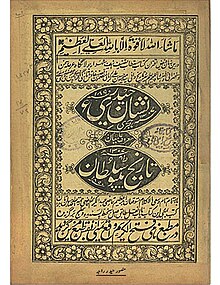Fathul Mujahidin
This article may need to be rewritten to comply with Wikipedia's quality standards. (March 2024) |

Fathul Mujahidin is a
Tipu distributed copies of his military manual to all of his officers.[3] In the manual he defined 200 men to handle rockets within each of the Mysore cushoons, with 16 to 24 cushoons of infantry. The personnel handling the rockets were trained to define the launch angle to properly affect the curve at which the rocket would land. Tipu also defined in the manual a multiple rocket launcher (much like a musical organ) that would launch up to 10 rockets. Some of the rockets had blades in the front of the bamboo guiding rods, while others were designed as incendiary rockets.
Although not the first use of rockets by Mysore, the 1792 Siege of Srirangapatna reportedly began with showers of as many as 2,000 rockets fired simultaneously.[4]
According to Stephen Oliver Fought and John F. Guilmartin, Jr. in Encyclopædia Britannica (2008):
Seringapatam in 1792 and 1799 these rockets were used with considerable effect against the British.[5]
See also
References
- ISBN 9780801887925.
- ^ Henty, G. A. (George Alfred) (1902). The Tiger of Mysore - A Story of the War with Tippoo Saib.
- ^ Husine, Prof. M (1986). "Fathul Mujahidin in Sultan". Journal of the Tipu Sultan Research Institute and Museum. 3.
- ^ Beatson, Alexander (1800). A View of the Origin and Conduct of the War with Tippoo Sultaun.
- ^ Encyclopædia Britannica (2008), "rocket and missile"
External links
"Indian Troops Rout British". NASA. Archived from the original on 15 February 2001. The English confrontation with Indian rockets came in 1780 at the Battle of Guntur.
"The Tiger and The Thistle"., focussing on Tipu Sultan and the Scots in India, 1760–1800
